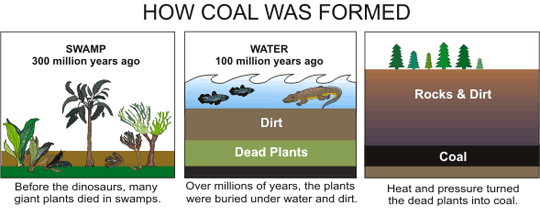Coal Takes Millions of Years To Create
Coal is a combustible black or brownish-black sedimentary rock composed mostly of carbon and hydrocarbons. It is the most abundant fossil fuel produced in the United States.
Coal is a nonrenewable energy source because it takes millions of years to create. The energy in coal comes from the energy stored by plants that lived hundreds of millions of years ago, when the Earth was partly covered with swampy forests.
For millions of years, a layer of dead plants at the bottom of the swamps was covered by layers of water and dirt, trapping the energy of the dead plants. The heat and pressure from the top layers helped the plant remains turn into what we today call coal.

Source: National Energy Education Development Project (Public Domain)
Types of Coal
Coal is classified into four main types, or ranks (anthracite, bituminous, subbituminous, and lignite), depending on the amounts and types of carbon it contains and on the amount of heat energy it can produce. The rank of a deposit of coal depends on the pressure and heat acting on the plant debris as it sank deeper and deeper over millions of years. For the most part, the higher ranks of coal contain more heat-producing energy.
Anthracite contains 86-97% carbon, and generally has a heating value slightly higher than bituminous coal. It accounts for less than 0.5% of the coal mined in the United States.
All of the anthracite mines in the United States are located in northeastern Pennsylvania.
Bituminous coal contains 45-86% carbon. Bituminous coal was formed under high heat and pressure. Bituminous coal in the United States is between 100 to 300 million years old. It is the most abundant rank of coal found in the United States, accounting for about half of U.S. coal production. Bituminous coal is used to generate electricity and is an important fuel and raw material for the steel and iron industries.
West Virginia, Kentucky, and Pennsylvania are the largest producers of bituminous coal.
Subbituminous coal has a lower heating value than bituminous coal. Subbituminous coal typically contains 35-45% carbon. Most subbituminous coal in the United States is at least 100 million years old. About 47% of the coal produced in the United States is subbituminous.
Wyoming is the leading source of subbituminous coal.
Lignite is the lowest rank of coal with the lowest energy content. Lignite coal deposits tend to be relatively young coal deposits that were not subjected to extreme heat or pressure, containing 25%-35% carbon. Lignite is crumbly and has high moisture content. There are 20 lignite mines in the United States, producing about 7% of U.S. coal.
Most lignite is mined in Texas and North Dakota. Lignite is mainly burned at power plants to generate electricity.



